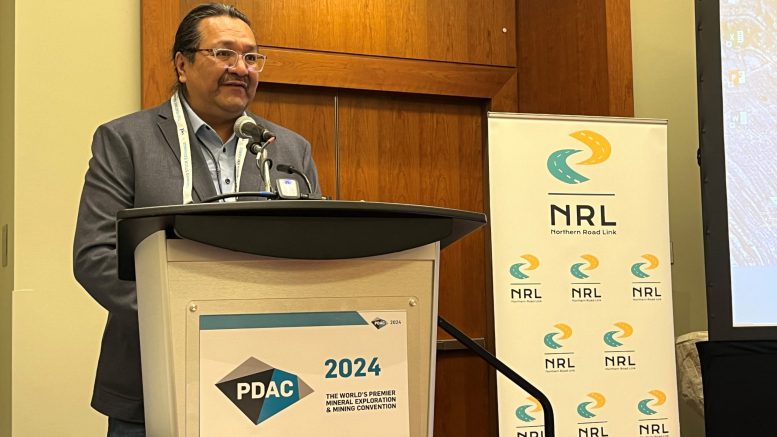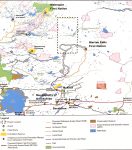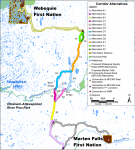Consultations continue with northern Ontario First Nations who are opposed to mining activity in the remote Ring of Fire region.
The Marten Falls and Webequie First Nations are the only two in the region to voice support for road and mining projects, while others such as the Neskantaga, Grassy Narrows, Wapekeka, and Big Trout Lake First Nations oppose the projects due to environmental concerns.
“We need community support and for us to be ready for mining development and large projects in our area,” said Marten Falls First Nation chief Bruce Achneepineskum on Tuesday at a Prospectors and Developers Association of Canada (PDAC) seminar. “It’s all part of what we call meaningful participation and taking the lead on these large scale projects. (In the past) we were treated as minorities without significant say on our traditional lands.”
Consultation is ongoing with some 22 communities, said Qasim Saddique, technical co-lead with consultancy Suslop, which is working with First Nations on environment assessments (EA) and design related to the Northern Road Link that would connect communities to proposed critical mineral mines in the Ring of Fire region.
“We have a strong interest in meeting with them to have a direct dialogue. We just had two Aboriginal and treaty rights forums in Thunder Bay. We want to know how the project might impact their traditional lands as well. They also have issues that aren’t necessarily with the road,” Saddique said at a Prospectors and Developers Association of Canada (PDAC) seminar on Tuesday about the road link.
The seminar came on the same day the Ontario government made an agreement with Marten Falls and Webequie on infrastructure related to the road link that would connect their communities to the proposed critical mineral mines and with the southern road network.
“It’s an honour to undertake this,” said Marten Falls First Nation chief Bruce Achneepineskum. “And as proponents we wanted to set the bar high in terms of delivering this environmental assessment, and ensuring that we reach out to all affected by this potential project.”
Maps of proposed road routes
- Where the proposed road would connect to the southern road network. Credit: Northern Road Link
- Credit: Northern Road Link
Webequie chief Cornelius Wabasse said his community looks forward to building a relationship with Marten Falls.
“We hope to continue to move forward for the benefit of our communities and the surrounding communities,” he said.
Their support marks a small step towards the potential development of mines in the region, where the most advanced project is Andrew Forrest-owned Wyloo Metals’ Eagle’s Nest. It has an estimated mine life of 11 years and would cost US$609 million to develop, according to a 2012 feasibility study. It hosts proven and probable reserves of 11.1 million tonnes grading 1.68% nickel, 0.87% copper, 0.87 gram platinum per tonne, 3.09 grams palladium and 0.18 gram gold.
The region, located about 540 km northeast of Thunder Bay, is accessible only by plane.
Saddique added that Suslop has been speaking with mining and exploration companies to learn about their needs as end users of the road.
‘Meaningful participation’
The Northern Road Link would bring together the 200-km Marten Falls Community Access Road at the south end, and the 110-km Webequie Supply Road to the Ring of Fire region at the north end.
Achneepineskum told The Northern Miner that his support for the projects is based on the need to transition to a new economy based on sustainability and an openness to change.
“(Other communities) can weigh the pros and cons and look at the benefits versus doing nothing and having no roads or infrastructure in our communities and no economic development,” he said. “We have to take a good hard look at those potential opportunities and our (perception) of those industries. We have to be objective and look at the bigger picture for our people.”
Costs not known
But while the larger vision might be there, specifics on the Northern Road Link have yet take shape.
Saddique said it was too early to make cost estimates on the road.
Victoria, B.C.-based The Narwhal, last year wrote that the project would cost more $2 billion, citing memos from the government of Premier Doug Ford.
Saddique said he expects the EA process to be finished by 2028, with construction of the road potentially starting the following year. The provincial government has fully funded the EA process, which Saddique said will cost several tens of millions of dollars. “We’re not releasing the exact figure. We hope for participation from the federal government for the development of the project in the future. But there have been no federal commitments at this point,” he said.




Be the first to comment on "PDAC 2024: First Nations manage tricky work of Indigenous consultation on Ring of Fire road"